#Frank Williams
Text



2023 F1 TEAMS ⟶ 7/10 ⟶ WILLIAMS RACING
“The first thing to remember is that all the really great drivers are bastards. They might come across as nice guys, and quite often they are—until the other nice guy beats them! I don’t hold that against them—it’s the way they’re made, and what makes them great: they must win." — Sir Frank Williams, founder of Williams Racing + longest-serving team principal in F1 history
#williams#williams racing#williams f1#alex albon#logan sargeant#aa23#ls2#james vowles#nigel mansell#frank williams#claire williams#jacques villeneuve#nico rosberg#ayrton senna#valtteri bottas#vb77#george russell#gr63#f1 edit#f1edit#vscpedit#velvetsainz.works#formula one edit#formula 1 edit#formula 1#f1#formula one#drive to survive#dts
181 notes
·
View notes
Text
Scarlet Witch and Quicksilver #2 textless preview
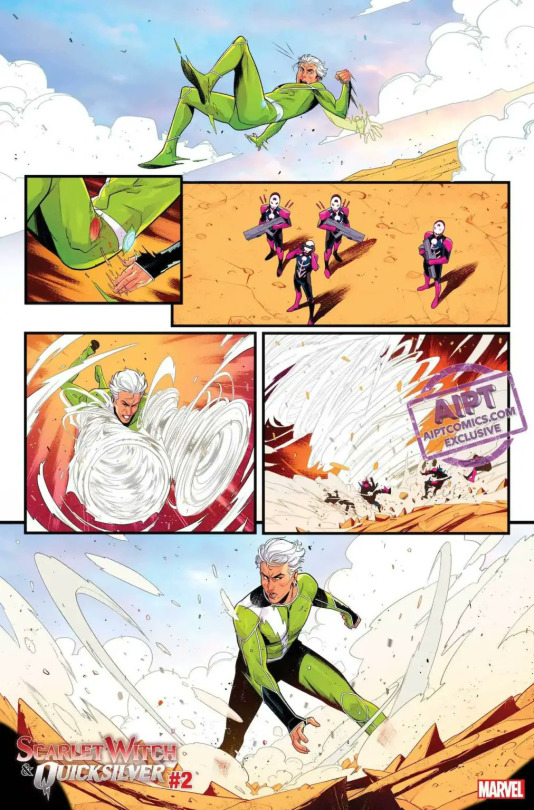

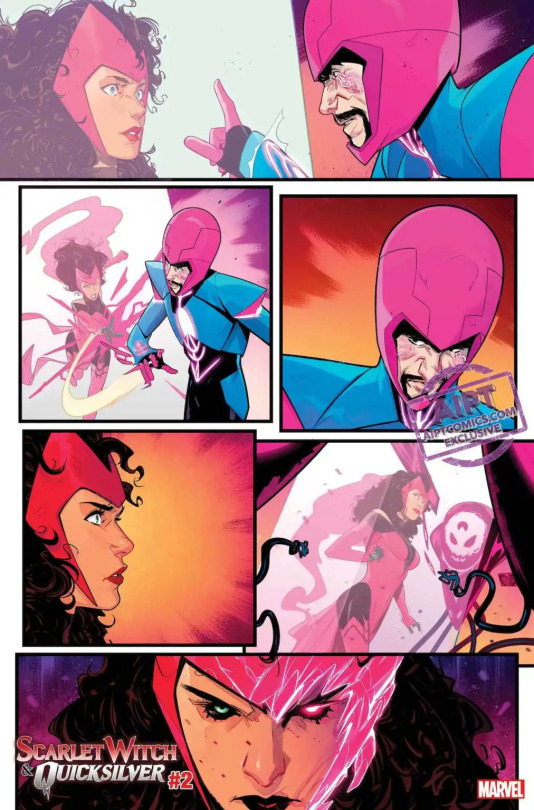

#scarlet witch & quicksilver (2024)#scarlet witch and quicksilver#maximoff twins#magnet family#pietro maximoff#wanda maximoff#quicksilver#scarlet witch#tommy shepherd#Speed#marvel 616#Steve Orlando#lorenzo tammetta#Frank Williams
83 notes
·
View notes
Text

has anyone considered that the Paul Ricard might be haunted??
54 notes
·
View notes
Text
How’d They Do That?
Special Effects & Stunts of Silent Cinema - Part 1
This is the first installment of an open-ended series where I try to highlight and illustrate the work of special effects and stunt artists of silent filmdom. Using articles from contemporary fan and trade magazines, I’ll make gifs or dig up images and/or video clips to accompany the descriptions of how the sequences were executed.
My notations will be bracketed and highlighted in a different color. Hope you all enjoy! Fair warning: this is a long read.
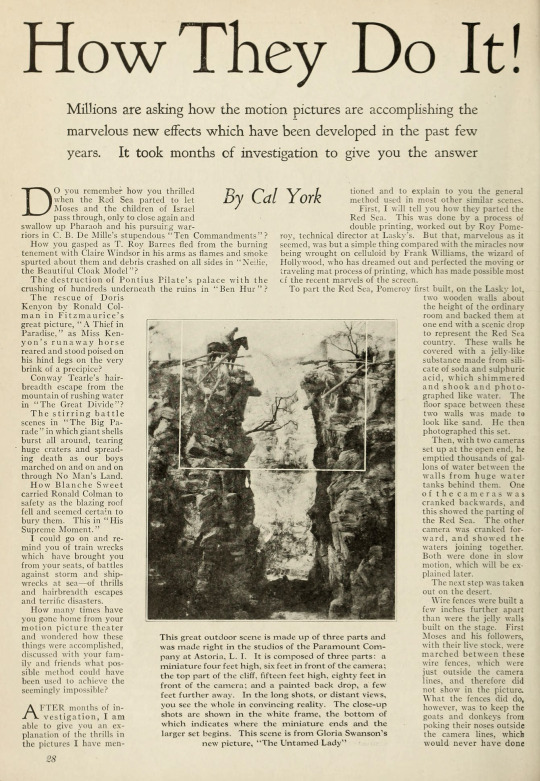
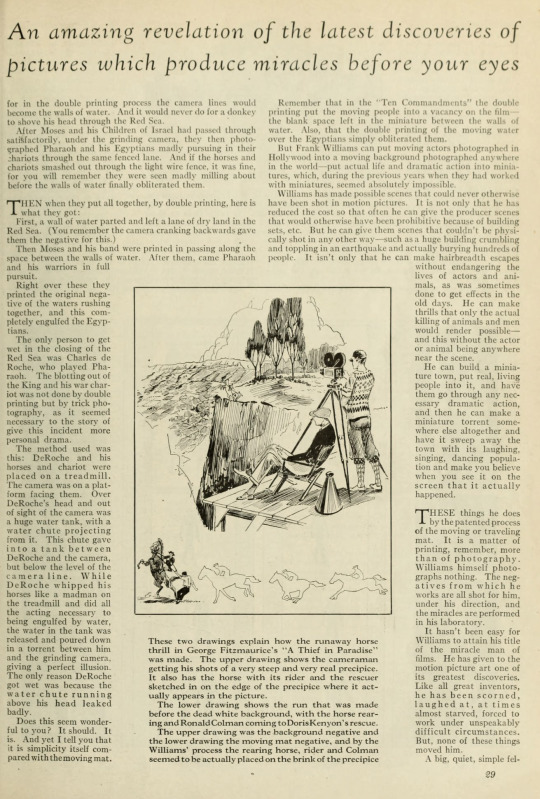
How They Do It!
[from Photoplay, April 1926]
by Cal York
Millions are asking how the motion pictures are accomplishing the marvelous new effects which have been developed in the past few years. It took months of investigation to give you the answer
DO you remember how you thrilled when the Red Sea parted to let Moses and the children of Israel pass through, only to close again and swallow up Pharaoh and his pursuing warriors in C.B. De Mille's stupendous "Ten Commandments" ?
How you gasped as T. Roy Barnes fled from the burning tenement with Claire Windsor in his arms as flames and smoke spurted about them and debris crashed on all sides in "Nellie, the Beautiful Cloak Model"?
The destruction of Pontius Pilate's palace with the crushing of hundreds underneath the ruins in "Ben Hur"?
The rescue of Doris Kenyon by Ronald Colman in Fitzmaurice's great picture, "A Thief in Paradise," as Miss Kenyon's runaway horse reared and stood poised on his hind legs on the very brink of a precipice?
Conway Tearle's hair-breadth escape from the mountain of rushing water in "The Great Divide"?
The stirring battle scenes in "The Big Parade" in which giant shells burst all around, tearing huge craters and spreading death as our boys marched on and on and on through No Man's Land.
How Blanche Sweet carried Ronald Colman to safety as the blazing roof fell and seemed certain to bury them. This in "His Supreme Moment."
I could go on and remind you of train wrecks which have brought you from your seats, of battles against storm and shipwrecks at sea—of thrills and hairbreadth escapes and terrific disasters.
How many times have you gone home from your motion picture theater and wondered how these things were accomplished, discussed with your family and friends what possible method could have been used to achieve the seemingly impossible?
AFTER months of investigation, I am able to give you an explanation of the thrills in the pictures I have mentioned and to explain to you the general method used in most other similar scenes.
First, I will tell you how they parted the Red Sea. This was done by a process of double printing, worked out by Roy Pomeroy, technical director at Lasky's. But that, marvelous as it seemed, was but a simple thing compared with the miracles now being wrought on celluloid by Frank Williams, the wizard of Hollywood, who has dreamed out and perfected the moving or traveling mat process of printing, which has made possible most of the recent marvels of the screen.
[Roy Pomeroy was head technical wizard for Famous Players-Lasky/Paramount (that is to say, he was their head special-effects engineer). We only know for certain about a handful of films that Pomeroy made specific contributions to, like The Ten Commandments (1923) and Wings (1927). As with many journeymen of the silent/studio era of Hollywood, the amount of films Pomeroy worked on was likely substantial, but many technical roles went uncredited at the time.]
To part the Red Sea, Pomeroy first built, on the Lasky lot, two wooden walls about the height of the ordinary room and backed them at one end with a scenic drop to represent the Red Sea country. These walls he covered with a jelly-like substance made from silicate of soda and sulphuric acid, which shimmered and shook and photographed like water. The floor space between these two walls was made to look like sand. He then photographed this set.

Then, with two cameras set up at the open end, he emptied thousands of gallons of water between the walls from huge water tanks behind them. One of the cameras was cranked backwards, and this showed the parting of the Red Sea. The other camera was cranked forward, and showed the waters joining together. Both were done in slow motion, which will be explained later.

The next step was taken out on the desert.
Wire fences were built a few inches further apart than were the jelly walls built on the stage. First Moses and his followers, with their live stock, were marched between these wire fences, which were just outside the camera lines, and therefore did not show in the picture. What the fences did do, however, was to keep the goats and donkeys from poking their noses outside the camera lines, which would never have done for in the double printing process the camera lines would become the walls of water. And it would never do for a donkey to shove his head through the Red Sea.
After Moses and his Children of Israel had passed through satisfactorily, under the grinding camera, they then photographed Pharaoh and his Egyptians madly pursuing in their chariots through the same fenced lane. And if the horses and chariots smashed out through the light wire fence, it was fine. for you will remember they were seen madly milling about before the walls of water finally obliterated them.
THEN when they put all together, by double printing, here is what they got:
First, a wall of water parted and left a lane of dry land in the Red Sea. (You remember the camera cranking backwards gave them the negative for this.)
Then Moses and his band were printed in passing along the space between the walls of water. After them, came Pharaoh and his warriors in full pursuit.
Right over these they printed the original negative of the waters rushing together, and this completely engulfed The Egyptians.

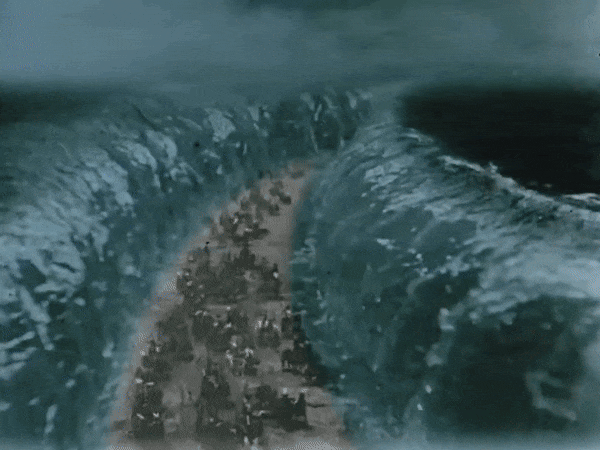
The only person to get wet in the closing of the Red Sea was Charles de Roche, who played Pharaoh. The blotting out of the King and his war chariot was not done by double printing but by trick photography, as it seemed necessary to the story of give this incident more personal drama.

The method used was this: DeRoche and his horses and chariot were placed on a treadmill. The camera was on a platform facing them. Over DeRoche's head and out of sight of the camera was a huge water tank, with a water chute projecting from it. This chute gave into a tank between DeRoche and the camera, but below the level of the camera line. While DeRoche whipped his horses like a madman on the treadmill and did all the acting necessary to being engulfed by water, the water in the tank was released and poured down in a torrent between him and the grinding camera, giving a perfect illusion. The only reason DeRoche got wet was because the water chute running above his head leaked badly.
Does this seem wonderful to you? It should. It is. And yet I tell you that it is simplicity itself compared with the moving mat.
Remember that in the "Ten Commandments" the double printing put the moving people into a vacancy on the film—the blank space left in the miniature between the walls of water. Also, that the double printing of the moving water over the Egyptians simply obliterated them.
READ ON BELOW the JUMP!
---
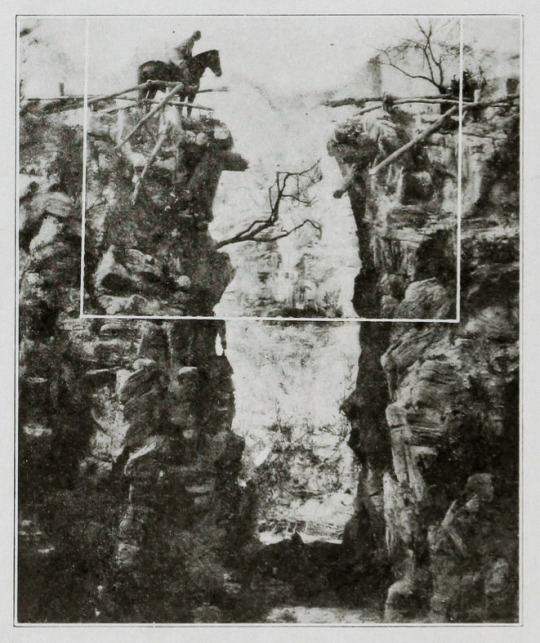
Photo caption: This great outdoor scene is made up of three parts and was made right in the studios of the Paramount Company at Astoria, L.I. It is composed of three parts: a miniature four feet high, six feet in front of the camera; the top part of the cliff, fifteen feet high, eighty feet in front of the camera; and a painted back drop, a few feet further away. In the long shots, or distant views, you see the whole in convincing reality. The close-up shots are shown in the white frame, the bottom of which indicates where the miniature ends and the larger set begins. This scene is from Gloria Swanson's new picture, "The Untamed Lady"
[The Untamed Lady (1926) is presumed lost, but luckily, a few images of this cliff-top sequence have survived.
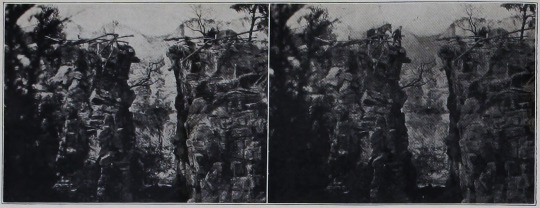

from Exhibitors Herald, 20 March 1926]
An amazing revelation of the latest discoveries of pictures which produce miracles before your eyes
---
But Frank Williams can put moving actors photographed in Hollywood into a moving background photographed anywhere in the world—put actual life and dramatic action into miniatures, which, during the previous years when they had worked with miniatures, seemed absolutely impossible.
[As you can gather from this article Frank Williams was a pioneer cinematographer and special effects artist. Williams was able to patent his moving matte process (and named it the Williams process) and it was an important effects technique used in film as as varied as Ben-Hur (1925), Sunrise: A Song of Two Humans (1926), The Lost World (1925), and The Invisible Man (1933). All of which are extant and easily accessible!
While it wasn’t in regular use for very long, the process was the basis for significant later developments in special effects photography, like green screening!]
Williams has made possible scenes that could never otherwise have been shot in motion pictures. It is not only that he has reduced the cost so that often he can give the producer scenes that would otherwise have been prohibitive because of building sets, etc. But he can give them scenes that couldn't be physically shot in any other way—such as a huge building crumbling and toppling in an earthquake and actually burying hundreds of people. It isn't only that he can make hairbreadth escapes without endangering the lives of actors and animals, as was sometimes done to get effects in the old days. He can make thrills that only the actual killing of animals and men would render possible—and this without the actor or animal being anywhere near the scene.
He can build a miniature town, put real, living people into it, and have them go through any necessary dramatic action, and then he can make a miniature torrent somewhere else altogether and have it sweep away the town with its laughing, singing, dancing population and make you believe when you see it on the screen that it actually happened.
THESE things he does by the patented process of the moving or traveling mat. It is a matter of printing, remember, more than of photography. Williams himself photographs nothing. The negatives from which he works are all shot for him, under his direction, and the miracles are performed in his laboratory.
It hasn't been easy for Williams to attain his title of the miracle man of films. He has given to the motion picture art one of its greatest discoveries. Like all great inventors, he has been scorned, laughed at, at times almost starved, forced to work under unspeakably difficult circumstances. But, none of these things moved him.
A big, quiet, simple fellow, only thirty-two years old. Shy, rather diffident of speech, he makes everything he does look easy. When he comes on a set, his quiet presence is scarcely noticed, and cameramen and technical experts go on spluttering and arguing, and when he is finally appealed to, he settles the problem so simply that everyone wonders why he didn't think of it himself.
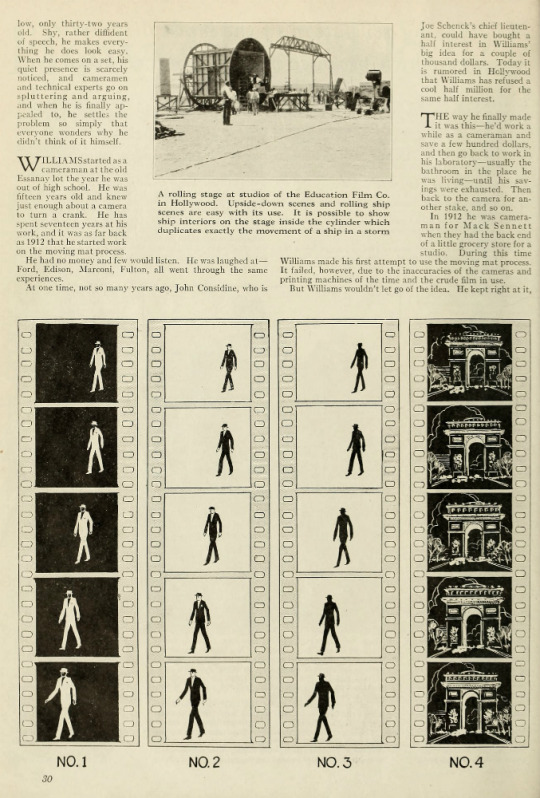
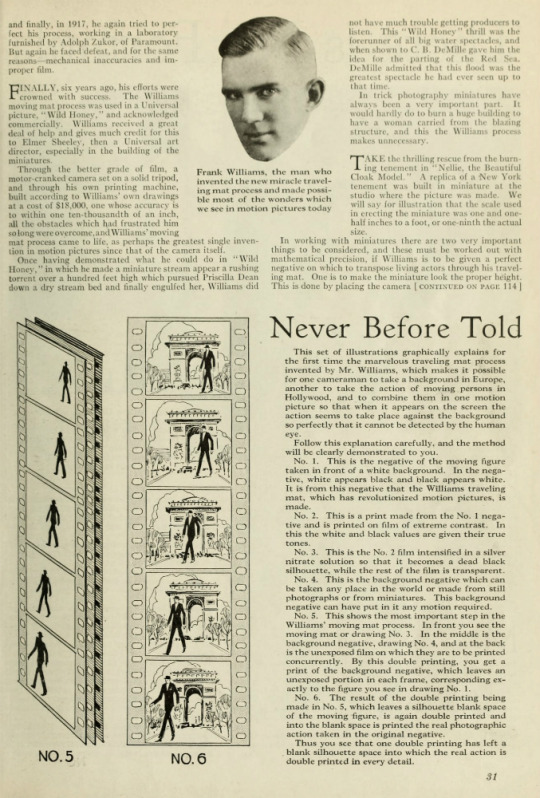
WILLIAMS started as a cameraman at the old Essanay lot the year he was out of high school. He was fifteen years old and knew just enough about a camera to turn a crank. He has spent seventeen years at his work, and it was as far back as 1912 that he started work on the moving mat process.
He had no money and few would listen. He was laughed at—Ford, Edison, Marconi, Fulton, all went through the same experiences.
At one time, not so many years ago, John Considine, who is Joe Schenck's chief lieutenant, could have bought a half interest in Williams' big idea for a couple of thousand dollars. Today it is rumored in Hollywood that Williams has refused a cool half million for the same half interest.
THE way he finally made it was this—he'd work a while as a cameraman and save a few hundred dollars, and then go back to work in his laboratory—usually the bathroom in the place he was living—until his savings were exhausted. Then back to the camera for another stake, and so on.
In 1912 he was cameraman for Mack Sennett when they had the back end of a little grocery store for a studio. During this time Williams made his first attempt to use the moving mat process. It failed, however, due to the inaccuracies of the cameras and printing machines of the time and the crude film in use.
But Williams wouldn’t let go of the idea. He kept right at it, and finally, in 1917, he again tried to perfect his process. working in a laboratory furnished by Adolph Zukor, of Paramount. But again he faced defeat, and for the same reasons—mechanical inaccuracies and improper film.
---
Photo caption: A rolling stage at studios of the Education Film Co. in Hollywood. Upside-down scenes and rolling ship scenes are easy with its use. It is possible to show ship interiors on the stage inside the cylinder which duplicates exactly the movement of a ship in a storm
[The rolling stage was used for lots of imaginative and comedic sequences in shorts and features. In the Lupino Lane short Movieland (1926), there’s a bit that shows the stage in action. Here’s a link to that specific scene, but the whole short is a lot of wacky fun and I recommend watching the full film!
Another illustration of how the rolling stage can be put to use is in When the Clouds Roll By (1919):
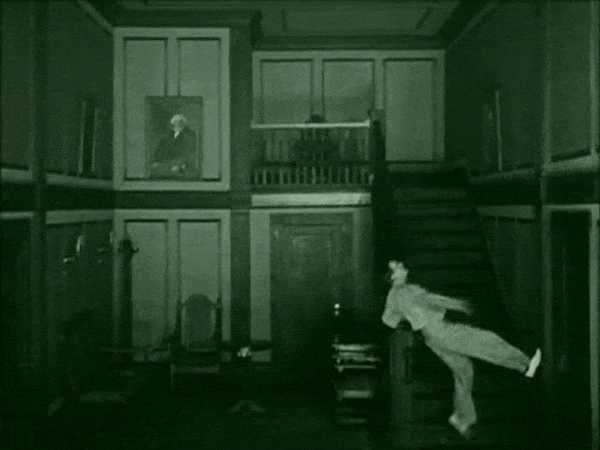

---
FINALLY, six years ago, his efforts were crowned with success. The Williams moving mat process was used in a Universal picture, "Wild Honey," and acknowledged commercially. Williams received a great deal of help and gives much credit for this to Elmer Sheeley, then a Universal art director, especially in the building of the miniatures.
Through the better grade of film, a motor-cranked camera set on a solid tripod, and through his own printing machine, built according to Williams' own drawings at a cost of $18,000, one whose accuracy is to within one ten-thousandth of an inch, all the obstacles which had frustrated him so long were overcome and Williams' moving mat process came to life, as perhaps the greatest single invention in motion pictures since that of the camera itself.
Once having demonstrated what he could do in "Wild Honey," in which he made a miniature stream appear a rushing torrent over a hundred feet high which pursued Priscilla Dean down a dry stream bed and finally engulfed her, Williams did not have much trouble getting producers to listen. This "Wild Honey" thrill was the forerunner of all big water spectacles, and when shown to C.B. DeMille gave him the idea for the parting of the Red Sea. DeMille admitted that this flood was the greatest spectacle he had ever seen up to that time.
[Unfortunately, Wild Honey (1922) is currently presumed lost and I was unable to find any depiction of Priscilla Dean fleeing from a torrent of water. As noted above however, there are quite a few extant films that also used Williams’ moving matte process.
In case you were wondering, I put $18,000 through an inflation calculator and it is equivalent to more than $315,000 in 2023 money!]
In trick photography miniatures have always been a very important part. It would hardly do to burn a huge building to have a woman carried from the blazing structure, and this the Williams process makes unnecessary.
TAKE the thrilling rescue front the burning tenement in "Nellie, the Beautiful Cloak Model." A replica of a New York tenement was built in miniature at the studio where the picture was made. We will say for illustration that the scale used in erecting the miniature was one and one-half inches to a foot, or one-ninth the actual size.
In working with miniatures there are two very important things to be considered, and these must be worked out with mathematical precision, if Williams is to be given a perfect negative on which to transpose living actors through his traveling mat. One is to make the miniature look the proper height. This is done by placing the camera the proper distance from the miniature (of course much closer than if it were a real building), and shooting from a lower level. The other is called timing. For example, if a miniature tree is to fall and the camera set-up is close enough and low enough to give the miniature the proper height when it is seen on the screen, then you must be careful of the speed with which it falls.
A little tree falls rapidly—a big tree slowly. And here is where the timing enters. Ultra speed cameras are used. The faster you crank the more pictures you get per second, and the slower the thing seems to move when you see it on the screen. You have all seen slow-motion pictures. These were made with slow-motion cameras, or what are more commonly termed ultra-speed cameras. And it is through this slow motion photography that the little tree is made to fall at the proper speed to be the big tree it represents, or the miniature stream is made to run at the proper speed for a giant river.
And so to get back to the fire which is still threatening "Our Nell." A torch is applied to the miniature tenement. At the proper count little invisible wires tied to window sashes are pulled and burning brands crash to the street below. And all the time the cameras, driven by motors at the proper speed, placed at the right distance from the conflagration and almost flat on the floor, are grinding away and recording this great fire.
[Nellie, the Beautiful Cloak Model (1924) is extant, with a print located at Gosfilmofond, but the film is not readily accessible. However, a depiction of the burning building sequence appears on an advertisement for the film:

from Film Daily, 28 February 1924]
OVER on some other part of the lot, and at any time which suits the director's convenience, T. Roy Barnes, with Miss Windsor in his arms, dashes through a black velvet door and down a street backed with more black velvet.
Two things must be remembered, however. The actors must come out of the velvet door at the right spot and at the right time or "count." This is necessary so that Williams can match up the fire negative, which is the background with action in it, with the negative of Miss Windsor and Barnes, which becomes the moving mat.
The remainder is simple, and is done by Williams and his printing process over at his laboratory.
On the screen you see Barnes dashing from a burning tenement with Miss Windsor in his arms while, in reality, neither of the actors has been close enough to a fire to singe a single eyelash.
Blanche Sweet's rescue of Colman in "The Supreme Moment" was worked out in the same manner as this, as have been most other burning building thrills in pictures made in the last few years.
[His Supreme Moment (1925) is presumed lost and unfortunately I was unable to locate a depiction of the burning building rescue mentioned here.]
Now for the destruction of Pontius Pilate's palace with the struggling mass crushed beneath, in "Ben Hur." Of course the palace was done in miniature, while the people did their acting out on the lot, where the street was built with a dead white backing. Again the timing had to correspond with that in the falling of the palace.
The throng of people was lined up and rehearsed. Two lines were drawn in the street a fixed distance apart—which represented the space where the ruins of the palace would fall, and the throng was sent dashing wildly down the street. At a fixed signal, all caught between the two marks fell flat on the ground. Those who had not reached the first line halted and registered terror. Those who had passed the second mark fled on, looking back and also registering terror. You see, those caught between the two marks were the people buried under the debris of Pilate's palace—those on either side had escaped.

Then came the trick printing with the two negatives, with considerable painting out of those who had fallen flat between the two lines, and you have the palace falling on the panic-stricken throng in the street. The accompanying drawings will help you to visualize this.
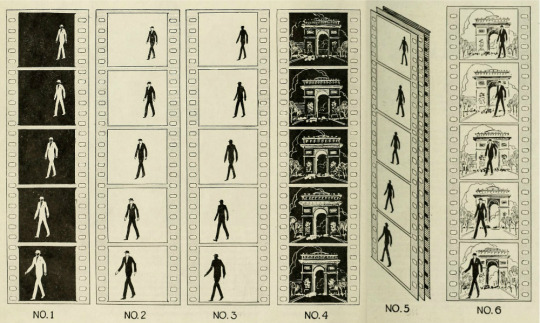
Never Before Told
This set of illustrations graphically explains for the first time the marvelous traveling mat process invented by Mr. Williams, which makes it possible for one cameraman to take a background in Europe, another to take the action of moving persons in Hollywood, and to combine them in one motion picture so that when it appears on the screen the action seems to take place against the background so perfectly that it cannot be detected by the human eye.
Follow this explanation carefully, and the method will be clearly demonstrated to you.
No. 1. This is the negative of the moving figure taken in front of a white background. In the negative, white appears black and black appears white. It is from this negative that the Williams traveling mat, which has revolutionized motion pictures, is made.
No. 2. This is a print made from the No. 1 negative and is printed on film of extreme contrast. In this the white and black values are given their true tones.
No. 3. This is the No. 2 film intensified in a silver nitrate solution so that it becomes a dead black silhouette, while the rest of the film is transparent.
No. 4. This is the background negative which can be taken any place in the world or made from still photographs or from miniatures. This background negative can have put in it any motion required.
No. 5. This shows the most important step in the Williams' moving mat process. In front you see the moving mat or drawing No. 3. In the middle is the background negative, drawing No. 4, and at the back is the unexposed film on which they are to be printed concurrently. By this double printing, you get a print of the background negative, which leaves an unexposed portion in each frame, corresponding exactly to the figure you see in drawing No. 1.
No. 6. The result of the double printing being made in No. 5, which leaves a silhouette blank space of the moving figure, is again double printed and into the blank space is printed the real photographic action taken in the original negative.
Thus you see that one double printing has left a blank silhouette space into which the real action is double printed in every detail.
---
The rescue of Doris Kenyon, which is also illustrated by the artist, was accomplished in this manner. One negative was shot of a very real and very steep precipice, the cameramen suspended on a platform far out over the edge to get the proper angle. Another negative was shot of Miss Kenyon's horse racing madly along what looked like a fence—but what was the inevitable white drop. Doris and the horse had to reach a certain mark at a certain count—for over at the precipice there had been rocks and dirt released at a certain count—the horse bad to rear, and Colman had to reach the frenzied beast, starting from outside the camera line, and he, too, must arrive on the right count. There could be no waiting for man or horse. They took it perhaps forty times before everything was exactly right, and then the two negatives (the precipice background and the moving mat) were ready for the printing wizard, and audiences got a great thrill.
[A Thief in Paradise (1925) is almost entirely lost. I profiled the film in my series Lost, but Not Forgotten in 2023.]
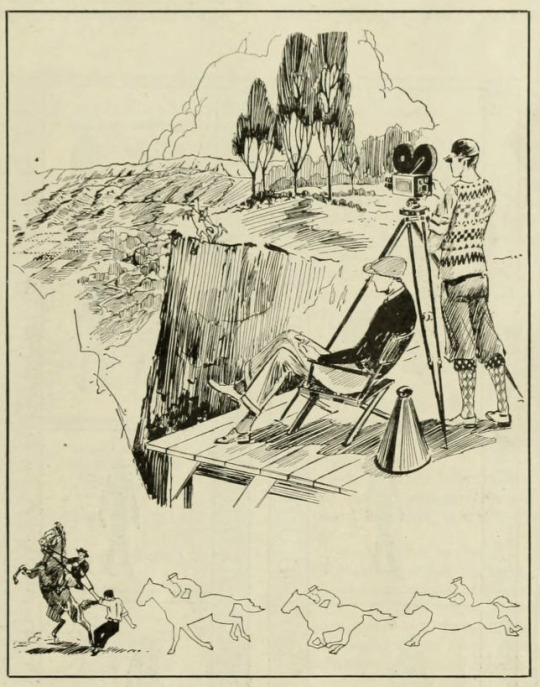
Photo caption: These two drawings explain how the runaway horse thrill in George Fitzmaurice's "A Thief in Paradise" was made. The upper drawing shows the cameraman getting his shots of a very steep and very real precipice. It also has the horse with its rider and the rescuer sketched in on the edge of the precipice where it actually appears in the picture.
The lower drawing shows the run that was made before the dead white background, with the horse rearing and Ronald Colman coming to Doris Kenyon's rescue.
The upper drawing was the background negative and the lower drawing the moving mat negative, and by the Williams' process the rearing horse, rider and Colman seemed to be actually placed on the brink of the precipice
---
You remember the mountain of water pursuing Conway Tearle in "The Great Divide." Of course they shot the torrent in miniature. Conway and his horse made their hairbreadth dash on a dark night and in an artificial rainstorm with nothing but a director threatening —then, although they did have quite a time making the steed climb a slippery and sloping wooden bridge, which was out on the back lot. Then up in Mr. Williams' laboratory, they finished one of the greatest thrills ever witnessed.
[While The Great Divide (1925) is thankfully extant at Cinemateket-Svenska Filminstitutet, it’s not easily accessible and I was unable to find a depiction of the effect.]
And the marvelous battle scenes in "The Big Parade." There were the big guns tearing huge craters in No Man's Land made on one negative, and the boys marched on and on and on in the other negative, and Mr. Williams brought them together in his printing laboratory. However, it was by no means as easy as it sounds, for this was one of the hardest pieces of moving mat printing ever accomplished.

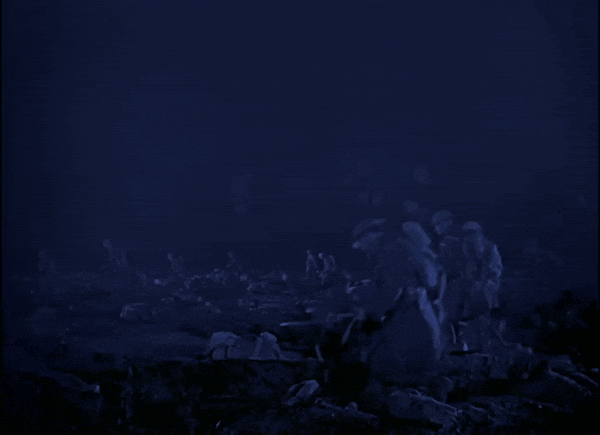

SO critical is the public that the building, photographing and printing of these miniatures must be of the very highest type of workmanship obtainable. It might be interesting to know that this work in "The Big Parade" alone cost approximately $70,000 for the background negative and the moving mat negative. The miniature battlefield was about one hundred thirty-five feet long and more than seven thousand miniature shells were fired in a period of forty seconds.
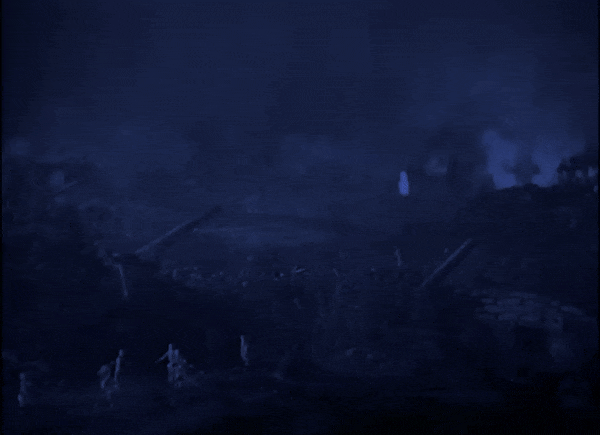



On another picture—"The Barrier"—which shows a fierce storm at sea, icebergs, and a ship caught and crushed in an ice floe, more than $85,000 have been spent to create these illusions.
[The Barrier (1926) is unfortunately presumed lost and I wasn’t able to find a depiction of this effect.]
Mr. Waller, technical camera expert of the Famous Players Long Island Studio, had never seen a cyclone; yet he was instructed to produce one for D. W. Griffith's picture, "That Royle Girl." Mr. Waller did extensive research work on the subject, and then made one to experiment with. A scientific knowledge of the working of the law of gravity, by the way, is necessary to create this phenomenon of nature.
[That Royle Girl (1925) is also presumed lost, and without film footage of this sequence there’s not really a way to know how the cyclone looked in the film. However, I do think the image highlighted in the advertisement below is likely from the cyclone sequence.
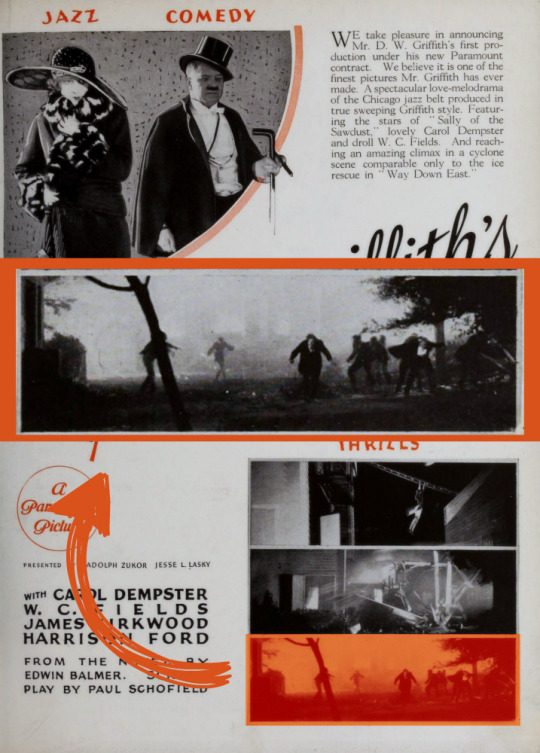
from Motion Picture News, 21 November 1925]
In the basement of the studio Mr. Waller connected up three vacuum cleaners. With three suctions of air and some dust, he made a tiny cyclone. This was photographed in slow motion so that the camera and technical crew might study the formation and activity of the cone.
From his observations of the film, Mr. Waller was able to prepare the series of wash drawings which, photographed in animated cartoon fashion, represented the action of the cyclone's cone in this sequence of the picture.
Several hundred drawings had to be made, each one depicting gradually the advance of the cone toward the Inn, which it finally demolishes. These were photographed in rotation on motion picture negative, and this negative double exposed on the 180-foot miniature scene containing the houses and trees. Thus we got a very good illusion of the cone of a cyclone advancing over a village and sweeping houses and trees out of its path.
[I wonder if/hope that some of these drawings have survived!]
The animated cartoon idea was also used in "A Kiss for Cinderella," when the pumpkin and mice change into the coach and four. The first few feet of the sequence showed real mice and pumpkin; from then on 256 wash drawings of the gradual transformation were photographed in rotation and gave the impression of being animated.
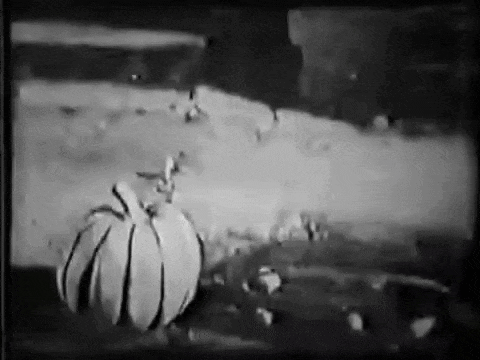
Double exposures of one actor playing two parts is the oldest and most familiar camera trick to the fans.
Just recently, however, has it been perfected to the point where the actor's two screen shadows can light each other's cigarettes and shake hands.
Tom Meighan, you recall, did this in Irish Luck."
AN invisible line from top to bottom divides each frame of the negative in half. One half at a time is exposed, photographing one half of the set.
Tom appears as Lord Fitzhugh on the left half, and as Tom Donohue on the right half. If you remember. Tom's two shadows are sitting side by side on a divan in the instance of the cigarette lighting. Fitzhugh leans over and gets a light from Donahue's cigarette. The illusion is perfect. But the cigarette from which his lordship really got the light was tacked onto a chair just outside the line, on the half of the set not being photographed at that moment. Only the lighted end of the cigarette projects into Fitzhugh's half of the picture.
[Irish Luck (1925) is extant at Eastman House, but it’s not currently easily accessible. I wasn’t able to find a depiction of this split-screen effect.]
Then when Donahue's half of the scene was being filmed, Tom leans forward and holds his cigarette in exactly the spot where the chair had been, the lighted end being outside his half of the picture. Think of the perfect matching this requires!
It is done this way. As Lord Fitzhugh performs on one side of the set, the director times his actions, counting the seconds out loud. He knows just where his lordship's right arm is, for instance, at the sixteenth second. When Donahue begins to perform on the other side of the set, his arm must be in a corresponding position at the sixteenth second. Tricky.
A thrilling moment in "Aloma of the South Seas," Gilda Grey's new picture, occurs when a shark eats a sailor. If you want this thrill, you naturally have to take it synthetic.
The shark cost $3,000. It was made of flexible rubber, and its insides consisted of a maze of electric wiring. Outside the body were several buttons which the actor could operate in his fight with the shark. It swims, wiggles its tail and bites electrically.
[Aloma of the South Seas (1926) is presumed lost and I wasn’t able to find images of the shark described here. However, as consolation, here is a photo from American Cinematographer of the film’s cinematographer Harry Fishbeck shooting on location in Puerto Rico:
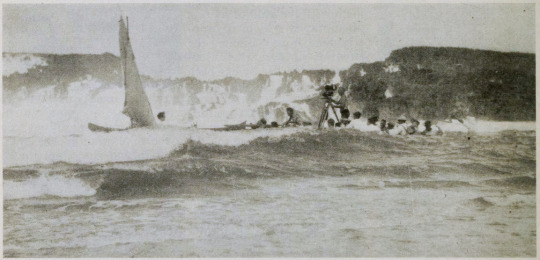
from American Cinematographer, February 1926]
I guess most of the suffering for art is done by the actors who tie themselves into knots to create the illusion of paralysis, amputated legs and so on. John Gilbert is shown in the last reels of "The Big Parade" with an amputated leg. Jack Barrymore in "The Sea Beast," also does it. It is merely a painful process of strapping the foreleg back. In "The Street of Forgotten Men," with Percy Marmont, a very lucid expose of cripple fakes is shown. Marmont had his arm strapped to his back for hours at a stretch during the filming of this picture. It hurts the first fifteen minutes, Percy said. After that the arm becomes numb.
A vigorous massage is necessary to bring it back to life, but it doesn't feel normal for weeks, Percy says.
Lon Chaney has his tricks of deformity down so pat that they are almost painless to him now.
#1920s#1910s#1926#classic film#classic movies#film#american film#my edits#silent film#my gifs#silent movies#silent era#silent cinema#cinema#film history#history#Roy Pomeroy#Frank Williams#Film Art#How'd They Do It#photoplay#lantern
57 notes
·
View notes
Text

Williams Racing
#williams racing#williams f1#formula one#formula 1#f1#alex albon#<3#logan sargent#keke rosberg#george russell#sir frank williams#frank williams#it's race week#!!!
24 notes
·
View notes
Text

#frank williams#keke rosberg#vintage f1#classic f1#the grip those marlboro logos have on me... throwback
13 notes
·
View notes
Text
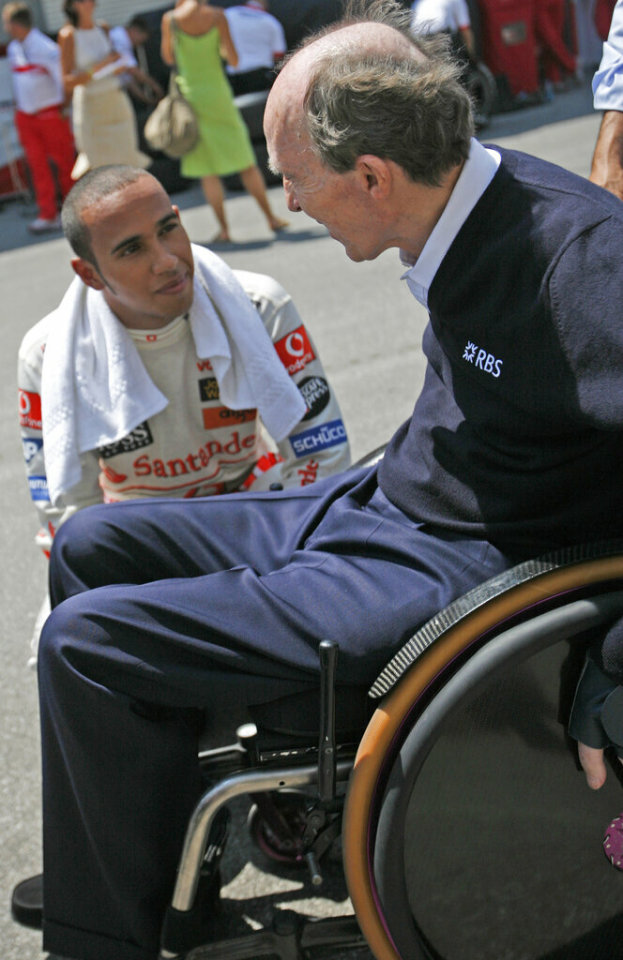
lewis hamilton chats with frank williams after fp2, united states - june 15, 2007
📷 aj mast / apimages.com
#lewis hamilton#frank williams#f1#formula 1#us gp 2007#flashback fic ref#flashback fic ref 2007#usa#usa 2007#usa 2007 friday
12 notes
·
View notes
Text
where does one aquire this tshirt
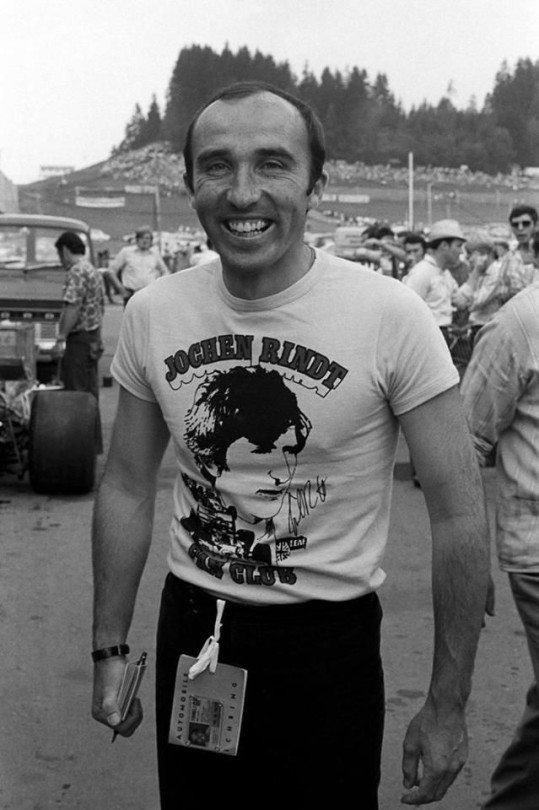
11 notes
·
View notes
Text

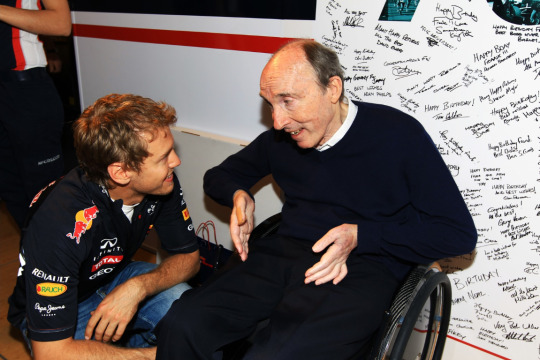


sebastian vettel chats with frank williams on qualifying day, spain - may 12, 2012
📷 sutton images / motorsport images
#sebastian vettel#frank williams#f1#formula 1#spanish gp 2012#flashback fic ref#flashback fic ref 2012#spain#spain 2012#spain 2012 saturday
17 notes
·
View notes
Text
He would "give anything" to see a duel between Lewis Hamilton and his driver Nico Rosberg: "We would possibly see a big surprise." He said he was one hundred percent sure that "the significant duel of the future will be Hamilton versus Rosberg" - provided the German gets a car capable of winning.
Frank Williams on Lewis Hamilton and Nico Rosberg (2007)
39 notes
·
View notes
Text
Aurum Gathering in the Athanor
Klemens Weidmann had once said there are two types of travel. The journey guided by a goal, traveling in hopes of reaching one’s destination. And the departure from the known, venturing into the unknown, whether driven by pure desire to explore, or for the sake of the journey itself, regardless of any discoveries, or in spite of the absence thereof.
When Frank Williams started his car that morning, he had harbored no idea of where exactly he was headed. In some ways, he defied Klemens Weidmann’s dichotomy. Frank Williams—in his fifties, single, unemployed, eccentric, cowardly, and obsessed with mapping out ley lines—had woken up that morning with the desire to just… drive.
He woke up in his car as he usually did. He got changed with the crumpled clothes out of his trunk that smelled the least offensive. He stopped at another diner to pick up coffee. And then… he would just drive. Hardly anything he could explain beyond chalking it up to vibes, he had set out, hoping to stumble across another powerful node in the ley lines for him to document, and started riding his old car down THE HIGHWAY.
He had an objective, but no destination.
Oblivious to how the day of reckoning had arrived.
In the year of 1995, Frank drummed his fingers against the steering wheel, merrily singing along to Paint It Black on his car radio as he enjoyed the wind in his messy gray hair, and the vastness of the open road. Consciously, he forgot about things like the arrest warrant on his name in Delaware for a dine-and-dash from a restaurant, or the stack of unpaid parking tickets, all dancing mad like butterflies as the wind swept them out a backseat window.
Unwittingly, he was only one among many whose spirit enriched the bloodstream of THE HIGHWAY. Carrying oxygen through the vast circulation of North America.
It took all of them to prevent the slow decay and the withering of its dying limbs. So close, sometimes, to grasping this truth of truths; and yet so far away, no matter how far he ever traveled.
Whether he knew where he was headed, or simply followed his heart that day, an old and withered heart rested in the heart of hearts in the center of THE HIGHWAY, and all their spirits thrummed in unison, in sync with this invisible heartbeat.
And Klemens Weidmann sat just outside that heart, in the dust and heat and winds of the desert surrounding Las Vegas.
The old rocking chair creaked as he rocked in it, to the same pace as the beat of a Rolling Stones song he could not hear. His wizened old hands tapped in tune against the armrests.
Sun baked the roof of the porch where he waited. Eyes closed, he smiled. Relaxed.
Finally time to relax.
The day of reckoning had come.
Agent Parker exited the ranch’s house, joining Klemens on the porch. This was not the original Agent Parker, but the homunculus. The new doppelganger he had fashioned.
He no longer remembered the face of his daughter. He no longer remembered the tragedy that claimed her. He only remembered that he had had a daughter once, and that he had lost her in tragedy. He had a vague idea of what that tragedy entailed, and he had done his part to avenge it.
“I can feel it, my king,” said the red-headed woman in the black suit. Though her body was comprised of clockwork parts, encased in a magicked facsimile of flesh and blood, she appeared all human. “She nears.”
Klemens exhaled a slow and satisfied sigh.
The day of reckoning indeed.
With eyes closed, he stewed in his own sweat, and relished the sensation of grease and grit on his old hands.
“Please, my dear,” he replied, “call me Klemens. I like to think of us as family.”
The homunculus cast him a sidelong glance.
“I am not of your kind, not… I, I am Promethean.”
The Way King chuckled.
“And yet, from all I’ve learned about Quinn Isabelle Parker, you sound just like her, even now. Promethean,” he repeated on the breath of another soft chuckle, eyes remaining closed. “What a beautiful word.”
“I understand the exchange you’ve made,” she said. “Are you never sad?”
He opened a single eyelid to study her.
Pale, freckled, inquisitive blue eyes hid a sadness behind their mirrors; mirrors in which he saw his old and failing body.
With both eyes wide open, he smiled warmly at her. The closest thing to a daughter he’d have in this final lap of his lifetime.
“No, my girl. If I cannot remember the sad things, I can no longer be sad about them. By giving away the old sadness, I find new happiness in my masterworks. And more, I find happiness in knowing all of you will outlive me, and go on do to great things. My only regret is how I will not get to see what kind of world you go on to create in my absence.”
The homunculus’ chin crinkled. Her eyes glistened with tears, fought back by the same spirit he had copied in creating her, drawn from the void between worlds, and forged from the brass and copper and steel and wood of the Heart.
Made real through the memories he had sacrificed.
Even now, she mirrored his sentiments. The wells of his old eyes had long dried up, thus no tears arrived. But he felt as she did in that moment.
“Oh, my sweet girl, do not be sad. I marvel at the thought of what things you may experience. I envy you for the journey you will embark on, to explore your spirituality, to explore your identity, like all magicians before me, and all who will follow.”
Her gaze hardened as she stared into the horizon, past the circuit of salvaged husks of car wrecks, and the long, lonesome road leading to the dead end of the ranch.
“It will not be the same without you… Klemens.”
The chair creaked in rhythm again as he continued rocking it to an invisible tune, nodding his head along.
“That is alright. As you asked, I shall answer. I am not so sad about what I lose, for I win so much in return. When I am gone, you will be in good company. The knights and magi who gathered to fill my court are good people. Pure, even when they must do wicked things. They will shape a future I can only dream of, and I take satisfaction in knowing that I had a hand in… paving the way.”
“But what about the Whispers I heard before my awakening?”
He joined her in staring down the road.
Clouds of dust rose in the distance, tiny specks on the horizon where a small caravan of cars approached.
Klemens sighed again, though no longer with satisfaction flowing from it. Though the end of his road neared, her question filled him with apprehension. It made his stomach knot.
Whispers.
“What Whispers?”
Whispers that lay dormant now. A Shadow lurked between the shadows.
A corrupting voice in the back of one’s mind. But it did not speak to her.
The homunculus swallowed an invisible lump in her throat.
“Before my awakening, while my consciousness coalesced from the echoes of hers, I heard these Whispers. Sweet and helpful at times, dark and menacing at others. Commanding, even. It was like they, like they had good intentions, but something… something’s just off about them.”
Klemens set his jaw.
The clouds of dust grew on the horizon. Three cars neared at a steady pace.
“Tell me more about these Whispers,” he said. “Why have you not told me about them before?”
His question lingered and her answer floated to the surface with painful slowness, like bubbles rising from the depths until they popped at the surface of a pond.
“They don’t seem real until they do. They helped me—her—in one moment, then demanded things in the next. Though I have her memories and consciousness, I am lacking many things, and it’s like… it’s like a soup in my mind. Mind soup. The memories do not come back to me in a linear fashion. They’re like puzzle pieces, and I have to start at the edges, working my way to the center as I complete the image.”
Klemens studied her again.
He had come too far to let doubt eat at him. To question this path, this quest, and the inevitable outcome he had engineered in assembling the Heart of THE HIGHWAY, the mechanical machine that connected the spiderweb of roads, siphoning spirit energy from every individual, and pumping out raw power to the far ends of its network.
This Parker—the second homunculus of her he had built—still stared into the distance, to the three cars steadily approaching. A rusty old Buick, Michael’s van, and a white stretch limousine.
Soft tremors echoed in her voice as she continued.
“I’m afraid this will end badly, for these Whispers are not something you accounted for. I’m afraid they will visit me, too, in time. I’m afraid they will try to… guide me. I’m afraid they will consume me instead. I know I’m not real—”
“Oh, no, no, my dear, please let me stop you there. You are very, very real. You may not have entered this world like other human children, but please make no mistake. You are very real. You are alive, and you can die like any human being. You can feel, and live, and remember, and dream, like everybody else.”
“But my destiny is predetermined, as artificial as I am. My purpose—”
“No,” he said softly. “My girl, you are like any other person. You are special for what you do, not what you are. There is no such thing as destiny, as a future written in books. There is no such thing as a destiny we cannot escape.”
“Yes, but—”
“Yes, I may have built you with purpose in mind. I created you for… a vision, a vision of peace. I created you to help build a better future. A better future for all. But you shall be your own woman, your own person. What you do with this life, with our world, is up to you.”
Wind howled through the ruins of the old chapel near the ranch’s house. A shovel, still staked outside a shallow grave in the dead fields, stood all by its lonesome, above which the breeze carried sand.
Strange lights glinted in the desert. Nobody noticed.
And the three cars continued to near, trailing behind them a large cloud of dust.
“But, please, indulge an old man, my dear,” he said. “Tell me more of these Whispers.”
Homunculus-Parker pinched the bridge of her nose. She cringed as if she felt a sharp pain in her head.
“They want me… no, th-they want her to do something. They’re helping her so she can help them accomplish… something. They haven’t said what, but I can feel it. They are benevolent, but only benevolent in the way a parasite would be. I can feel it. Like I can feel her nearing now. She’s in one of those cars out there. She is distressed, like I am. Scared. Scared of what happens when we both gaze into the mirrors. What happens when the mirrors collide. Will we both shatter? What is left behind if we shatter?”
Klemens stifled a sigh as he rose from his rocking chair.
His wizened old hand, scarred and wrinkled and strong despite its frailty, found hers.
Squeezed it.
Just like he used to squeeze his daughter’s hand, oh so long ago. A memory that had slipped through the cracks.
He smiled.
“We are human, you and I and her. We are not made of glass. We are like… aurum horizontale. We have attained the weight of gold, but are only on the verge of reaching citrinatas. We do not shatter like glass, we melt and solidify in the athanor. The… the Whispers. What do they say?”
The airbrushed painting of a wizard on the van turned visible, so close had it gotten to the scrapyard in front of the ranch house. Where THE HIGHWAY’S ultimate road ended, it turned to gravel, crunching underneath the many wheels carrying their chariots towards the Heart.
The homunculus finally articulated a description of the Whispers.
Something concrete.
And it sent chills down Klemens’ spine.
“They sleep at the bottom of a dark ocean of consciousness. They ask her to take their hand, and pull them to the surface. They promise many things and offer aid in return. She does not fully trust them. I do not fully trust them. She… we… trusted before, and learned from past betrayals. They… it’s…”
Her words trailed off. Interrupted by the three vehicles rounding the circuit in front of the house. Wheels kicked up gravel and dust as they slowed down, heat rising from the hoods, and silhouettes of figures moving inside the cars, concealed by dust and dirt and tinted windows each.
“It’s not human,” concluded the homunculus.
Klemens shuddered.
“There are only humans and animals in this world,” he countered.
“And ghosts? And demons?” she asked.
“They are also humans and animals,” he said, darkening on every syllable.
“This… thing… is neither,” she said.
He shuddered again.
Michael emerged from the passenger’s seat of the old rusty Buick, Jericho’s car. He cracked a crooked smile as he waved at Klemens. The original Special Agent Parker climbed out of the driver’s seat, casting a glance in the round until resting her gaze on her doppelganger on the porch.
Then the homunculus added, “But it’s not here, Klemens. I don’t… feel it. I don’t think it’s here.”
She was wrong. Utterly wrong.
The Shadow lurked in the darkness of the house behind them. It waited.
It watched.
FBI director Anthony Collins hopped down from the driver’s seat of the wizard van, slamming its door shut. He tilted his head and stretched his neck as he approached the ranch like Michael and Agent Parker.
Klemens stared at the white limousine with vested interest, as its presence planted another seed of doubt in his belly, joining the one that festered upon hearing of these Whispers.
From the silver chariot, gleaming in sunlight, emerged three figures.
A black man dressed like an FBI agent—presumably Agent Wells, whom he had heard of from Anthony.
A blonde, middle-aged woman in an expensive designer dress, clutching a tiny purse in one hand, and a silver hip flask in the other, from which she took a hearty swig upon staggering out of the limousine.
And a bodyguard, as tall as a giant, with steroid-laced muscles almost bursting out of his suit, suggesting he could tear a telephone book apart with his bare hands.
Klemens’ nostrils flared and he collected himself, fighting back a frown from marking his mien.
To hide his disappointment.
Such a momentous time, and he had expected Jericho and Karma to show up for it.
It would have been such an apt succession.
As the group gathered before the porch, Klemens asked Michael, “Still no sign of Jericho and Karma?”
Klemens descended down the weary old stairs, the wood creaking under every step before he traversed the gravel to join the gathering. The homunculus followed him, drawing three burning stares from Agent Parker, Agent Wells, and the blonde woman in the designer dress.
Michael shrugged and frowned. “Not a peep, my king. Though, to be quite honest, I haven’t made any effort to look. Bigger fish to fry, and all that. He is probably sleeping off a hangover in Vegas and she’s probably… doing whatever she does between her, uh, work?”
He grinned.
Klemens nodded and approached Agent Parker.
He extended a hand for her to shake.
She only stared at her doppelganger, one step behind him.
“How dangerous is she?” asked Parker.
“Man, you’ve got some nerve,” Agent Wells grumbled. Then with more volume, and indignant anger rising to the surface, he said, “You all got some real nerve.”
Wells glared at Collins. The FBI director kept a straight and stony mask of an expression, not maintaining eye contact with his former friend. All he did was adjust the thin frame of his glasses.
Wells continued, still glaring at Collins, then letting his accusatory gaze sweep among the others present. His voice quaked with fury and he enunciated his words with a heft to match.
“We find ourselves here in the company of murderers. It feels like yesterday that we would have been here to apprehend these murderers, and it is taking me everything to hold back from doing what we set out to do.”
He flapped his jacket open to expose his holstered gun.
Parker shot him a glance and shook her head. She said nothing.
Michael looked Wells up and down, projecting an air of exhaustion as he shot out a flat breath.
Klemens withdrew his hand and nodded.
“You are right, Special Agent Wells,” said the Way King, contrasting Wells’ tone with a gentle response and a faint smile. His German accent served to deepen that contrast. “I apologize for the circumstances under which we all come together like this. I can only humbly ask you to hear me out first.”
Michael interrupted him, “There is an abridged version of everything, which I’m happy to—”
“You fuck,” the blonde woman blurted out. She took another swig from her flask. Angrily. “Your Gravedigger killed Mac, you sneaky fuck. And you were the one who put me on the path of looking for that stupid fuckin’ book. We’re gonna get to the bottom of this, but rest assured, your ass is on thin fuckin’ ice, mister, and I have a nine-millimeter bullet that’s thirsty for your gray matter.”
Parker glared at her in turn.
“Aria, the dead don’t speak. Please.”
“Yes,” Klemens said, folding his hands in front of himself like a man of prayer. He then extended both as if surrendering, offering them to slap handcuffs onto his wrists. “I will be as candid as I can be, and share all I know with you. I promise that my intentions are pure, and if, once all is said and done, you still wish to arrest or execute me, I will offer myself up to your judgment. All I ask of you is a modicum of patience, and a sliver of your time on this Earth. Please, let us gather inside over some fine refreshments, and, as they say, hash things out. Yes?”
Michael crinkled his nose and scratched it.
Wells growled, clearly directing his ire at Anthony, Michael, and Klemens.
“It’s just like Aria just said. Thin fuckin’ ice, gentlemen.”
BANG. RATATATATAT. BANG-BANG-BANG.
All hell broke loose.
Puffs of gun smoke joined the clouds of dust, swept away by desert breeze. A cacophony of thunderclaps, of gunshots, all ripped through the air, breaking the silence of sandy wastes.
Rifles belched out deadly slugs, some chattered like vicious fireworks as they spat out salvos of automatic fire. Bullets tore up dirt and sent gravel flying wherever they hit the ground, and they caused chunky THUNKS when they hit the metal of cars. A tire hissed upon a bullet punching a hole through it.
Everybody gathering in front of the ranch house instinctively ducked or tucked and rolled, leaping for cover. Others fell upon getting shot, dropping on the spot.
RATATATATATATAT. RATATAT. BANG-BANG. BANG. RATATATAT—
Swearing, words of oath that dissipated underneath the infinite blue sky. The lenses of scopes reflected sunlight when spotted by the victims of the shooting.
Wells shouted from behind the Buick. “Parker!”
A salvo of shots ripped through the car’s body, leaving a stitched line of crude bullet holes, forcing him back down into cover behind the vehicle.
Parker groaned as she gritted her teeth, gripping her side, crawling towards the stairs to the house’s porch, leaving a trail of blood behind her in the sand.
Barry the Bodyguard popped out from behind the Buick’s trunk, gripping a pistol dwarfed by his big meaty hands, returning fire at the hidden sharpshooters surrounding the ranch, forcing one of the adversaries into cover.
BLAM-BLAM, BANG-BANG, RATATATATAT—
Aria, hunkered down next to Barry, fumbling with her purse, pulling from its bowels a tiny silvery pistol to match the silvery flask in her lap.
“Motherfucker,” snarled Michael through gritted teeth, gripping his belly.
Blood pumped out between his fingers at an alarming rate.
Collins pumped the pump-action shotgun he retrieved from the van, ducking just in time before a series of three rifle shots tore up the van’s hood and left a spiderweb of cracks on its windshield.
“Klemens!” shouted the homunculus.
She helped drag both the old man and the wounded Agent Parker up the three steps onto the porch, where more shots landed, splintering wood, and shattering the weathered railing.
“I can’t,” Klemens replied through bloodless lips. He spoke with an eerie calm. “My legs. I can’t move them.”
The rocking chair exploded into small wooden chunks from a stray rifle bullet.
BANG-BANG-BANG, BLAM-BLAM, RATATATATATA—
A moment of dead silence followed, punctuated by labored breathing, hectic clicking, and groans. Guns were being reloaded. The sharpshooters barely moved behind their cover. They had chosen their positions with deadly precision.
“Five,” Wells shouted with his weapon drawn, peering past the busted headlight of the Buick.
“Four more,” Collins shouted back before diving inside the van, vanishing in its cabin.
“Son of a bitch,” Michael hissed, “I forgot how much bullets hurt. Anthony!”
A car door groaned as Barry swung it open to add cover for himself, Wells, and Aria, where he ducked down, surveying their surroundings for the sharpshooters they had called out.
“What?” Collins shouted back.
BLAM-BLAM.
Bullets kicked up dust near Michael where they hit the ground, and he stumbled as he tripped and limped his way up the steps of the porch. More and more blood splattered the sound, escaping his body.
“You motherfucker! Anthony! You did this!” Michael yelled, breaking out into a fit of coughing.
“What?” Collins yelled back. Exasperated.
The Shadow smiled.
To nobody in particular, it whispered.
Oh, that’s rich, Mikey.
“You did this!” Michael yelled again. “What the hell do you think you’re doing?”
The homunculus and the injured Agent Parker had vanished inside the house just before another series of gunshots tore across the ranch. The targets returned fire upon the attackers.
BRATATATATATATBLAM-BLAM-BLAMBAM-BANG-BANG-RATATATATATATA—
Window panes exploded, wooden supports to the porch’s roofing collapsed, and car bodies swallowed dozens upon dozens of bullets, rocking under every impact.
“How dare you?” Michael yelled. He fell inside the shadows of the house.
Wells glared at the van where Collins hid.
Barry popped out of cover in a lull between shots—
BANG-BANG-BANG—
A yelping man’s cry erupted from the distance, just before a stranger’s figure crumpled to the ground behind the cover of a pile of old car husks.
The wizard van’s engine roared and its wheels kicked up gravel. Collins hadn’t even bothered to slam the door shut behind him, letting it flap and crack open and closed as he steered the van around.
“Anthony!” Wells hollered. “You better run, you fucking coward!”
The FBI agent’s face oscillated between uncontrollable rage and righteous fury. Wells popped out of cover just as another sharpshooter’s shot sent Barry into hiding again. Aria joined him.
They blazed away with their pistols.
Two more bodies dropped into the desert sands.
Winds howled through the ruined chapel, where another scope’s lens glinted in the sunlight.
RATATATATATATAT—
Sparks flew and bullets chewed away at the dying and battered body of Jericho’s Buick. In a drunken stupor, Aria stumbled into Barry, who lost his balance, and knocked into Agent Wells, crashing all three of them face down into the dirt like dominos—
BRATATATATATATATATATAT—
The three fell splayed, sprawled out, and sputtering dust, and coughing, and scrambling, to find new cover—and just low enough to evade the salvos of automatic fire. Aria’s drunken stumbling had saved the three of them.
Clicking. Furious clicking. Reloading.
They stumbled and shoved each other to the house in a mad dash.
The van engine’s growls died down as it gained distance, trailing down the road, swallowed by a new dust cloud.
The sharpshooters did not target it.
Everybody had fled inside the house. Three trails of blood led inside.
Chests and shoulders heaved. Adrenaline pumped in every body. People grunted, ducking behind the cover of sad old dusty furniture, eaten by the sands of time, now bearing new wounds, chipped away by stray shots. Windows gaped open with broken shards, and the screened door to the entrance flapped in the wind, lazily slapping against its frame.
The shooting had stopped.
The Shadow still watched. Waiting.
“I can heal us,” Michael said, crawling over to Klemens.
The old man’s head rested on a thin beaten-up pillow, and a dark crimson color spread beneath him, soaking a worn Afghan rug.
“I can fix this,” Michael breathed.
“It’s too late,” Agent Parker hissed through gritted teeth. Her eyelids fluttered as she fought against paralyzing pain.
“Never too late,” Wells barked back, cradling Parker’s head on his lap as he looked for the bullet wound that was drenching her white shirt in merciless red.
“You gotta get him,” Michael said, “You gotta get Collins and bring him back here so we can figure out what the hell this was all about. Only way we’ll stop whatever he did, only way we’ll find the hornet’s nest he kicked.”
“Can you stretch your legs?” the homunculus asked.
“I cannot feel my legs,” Klemens replied with the same eerie calmness.
With eyes closed, he smiled.
Michael’s voice trembled. “Look, I can heal you. I can heal us. I’m always ready for something like this.” Then, to Wells, he said, “But you got guns, you got guts—you know him—you got what it takes to get Collins, so he can answer for this. Bring him back alive so he can answer.”
Wells squinted at him. Aria squinted at him, wiping dirt from her cheek. Barry, who had lost his sunglasses, also squinted at Michael.
And the Shadow smiled.
It finally offered a Whisper. A tiny olive branch. Something only Michael could hear.
Oh, Mikey, what a snake you are.
Michael’s face fell.
Haunted.
Eyes wide, all blood drained from his cheeks.
It even helped sell his ruse. The Shadow spoke to him with melodious malice and mockery.
Yes, it’s ME. You’ve always wanted to hear me, right? Ever since you hijacked their perceptions, and heard me WHISPER, you’ve wanted this, right? Wanted to talk to me? Well, here I am, Mikey.
IN ALL MY GLORY.
Where darkness pooled in the house, in the most unfathomable corner of the room behind the wounded Parker, and Klemens, and the homunculus, there it was—
Tiny dots where sunlight glinted upon reflections of objects… resembling a multitude of alien eyes.
Its shadowy face split open in a vertical smile, dripping with insubstantial tar.
The Whispers cackled, audible only to Michael. Then they growled and snarled in the voices of a thousand. Many in one, one in many.
HERE I AM, MIKEY.
Michael had never felt so afraid in his entire life. His body tingled. The terror paralyzed him.
That fear—that dread—it broke the dam of his coolness, flooding the valley of his assertiveness, and it spilled out from his soul, gripping his body, leaking like the blood from his gunshot wound—
And selling his terror. How small the Shadow made him feel in that moment.
It had just helped sell the act better than Michael could have ever sold it.
Wells clicked his tongue.
He snarled at Michael. “You are damn right I’m gonna get Anthony back. And then you are all going to answer for this—for everything. If you do not heal Parker, then so help me God, I will make life a living hell for you.”
Before he could rise to creep out through a backdoor, Aria stopped Wells, clutching his wrist to the point of painfulness.
“You’re not going alone,” she said.
Before he could utter any protest, she shushed him with a raised index finger, and emptied the rest of her flask’s contents into her gullet. Wells said nothing, just clenching his jaw and shaking his head.
“Be… careful,” Parker eked out. Then she groaned in pain.
“This doesn’t sit right with me at all,” Wells said, shaking his head. “Leaving you with him, and… that thing.”
He cast one last glare at the homunculus. The homunculus did not meet his gaze… exactly like Parker.
This wiped the anger from his expression.
Confusion claimed Well’s face. In that moment, he saw something in that doppelganger. Something vaguely familiar. And the realization paralyzed him in turn.
“I’m… a big girl, Derek,” Parker said with a forced grin, barely keeping her eyes open. “Strange times… a strange world… makes for strange bedfellows, man.”
She still held a hand pressed over the gunshot wound in her side, where blood still wept. The very sight of her state made Wells cringe.
Then his expression hardened. The old drill, discipline, and routine returned to him. The ranger kicked in. He had a job to do.
“You have been warned,” he told Michael before leaving.
Aria and Barry snuck outside with him.
For now, the desert remained silent. No gunshots followed. Gravel crunched as the three crept between the husks of old decrepit buildings and eviscerated car wrecks.
Wide-eyed and terrified, Michael still stared into the darkness. Into the dozens of tiny white dots, the alien eyes. They blinked.
Dread cut his thoughts short and his breaths even shorter.
The Shadow still smiled at him with its terrible smile.
Come on, Mikey, it taunted him with more sinister Whispers. Don’t you have work to do? I can’t heal any of you, you know. That’s in your ballpark.
“You need to heal Klemens,” said the homunculus, lightly tapping Klemens’ cheek. “He’s no longer responsive.”
And as Agent Parker’s consciousness faded, she groaned again, trying to sit up. Michael crawled until he arrived by her side, laying a hand upon her bullet wound.
“No,” Parker wheezed. “Heal… the Way King… first.”
The Whispers no longer spoke to Michael.
The Shadow now whispered to Parker again.
In perfect control, it projected different Whispers her way.
Tender. Soothing.
You… listen. Listen.
Blood pumped. Adrenaline rushed. The light of the world slowly faded.
“He’s still breathing, but you must hurry,” said the homunculus.
You need to stay awake. Our task is not complete.
“What do… you want?” Parker squeezed out between shallow breaths, panting.
“To heal you,” Michael answered instead.
Flesh and blood squelched as her body twisted on the inside. The bullet crumpled within her, crushed like coal into a diamond, briefly causing more blood to flow, and forcing another groan out of her throat as her back arched reflexively against the pain. The bullet rose to the surface, following the dark pull of Michael’s magick.
The wound spat the bullet out into his palm. He tossed it aside and it clattered on the floor.
Near the Shadow.
“I need you,” he said.
Darkness encroached around the edges of her vision.
She believed him. In that moment, Parker had reason to believe him.
Things never work out as we plan, do they? I understand that now. A lesson this world has taught me. But rest assured, all is in good hands. We’re on the right track, you and I.
Parker passed out.
The Shadow’s tone switched again as it granted Michael more Whispers. More Growls.
Oh, do I understand it now.
You and I are destined to accomplish wonderful things together, Mikey.
WONDERFUL THINGS.
All you have to do next is… let me in.
LET ME IN.
LET ME IN.
#spoospasu#spookyspaghettisundae#horror#short story#writing#literature#spooky#fiction#mystery#THE HIGHWAY#Frank Williams#Klemens Weidmann#FBI#Agent#Parker#occult#magick#ritual#alchemy#homunculus#doppelganger#Promethean#collective unconscious#Jung#Shadow#citrinatas#athanor#aurum#sorcery#Way King
4 notes
·
View notes
Text
Scarlet Witch and Quicksilver #3 review
4/5 Stars - Spoilers below the cut

Another solid issue - better than the first one but not as good as the last one. I owe this to building up to the climax in the next issue.Wanda took a backseat this issue but her Cthon form is very cool. The Tommy and Pietro interactions were great and we have a sweet (for Pietro) moment between the two which finally acknowledged David's death and Tommy's grief and how he doesn't want to lose his uncle and mom. Pietro discourages his nephew from walking into a trap with him and shows that he's the type of dad that tells his kids to beat up their bullies back. Great moment bit not enough of Tommy sadly.Orlando is hitting his stride writing Pietro. You can tell he is having a blast writing Pietro. We get more cool uses of Quicksilver's powers including remembering he can phase through and explode stuff. He saves his sister while vision just stands around haha.The twins on reuniting are still pissed at each other and the interactions afterwards are delightfully passive aggressive and petty. Regardless of that it's clear they will kill for each other and that's part of what makes the twins dynamic so iconic! Pietro gloating to Wanda that he's Target one is peak twin energy! We get more lore building with the twins and the giver. The giver says they upend the design and Vision theorises this has to do with Wanda being magic and Pietro science - two means of exploring reality. I am keen to see how this plays out.Speaking of Vision - he wasn't so bad this issue, there to be an exposition machine (and still a deadbeat dad) I kind of enjoyed him (though if he exits stage left right after this no complaints for me). It's clear Orlando has no interest in getting Wanda and Vision back together and plays them as amicable ex's and friends and it's so much better for it. Visions affection for the twins is clearly here. Vision of all people defending Pietro and calling out Wanda for the letter was a pleasant surprise and Wanda doesn't refute his accusation she did it to be petty. I am curious as ever as to what the letter says as Magnetos murder of Pietro is again brought up and Magneto is finally acknowledged as being a shit dad.Excited for the next issue!
Tammetta's art has been really great and I love that the twins look like twins for once! All supported by wonderful vibrant colouring.
#scarlet witch and quicksilver#pietro maximoff#quicksilver#wanda maximoff#maximoff twins#magnet family#tommy shepherd#Speed#The Vision#Steve Orlando#lorenzo tammetta#Frank Williams#Russell Dauterman
6 notes
·
View notes
Photo

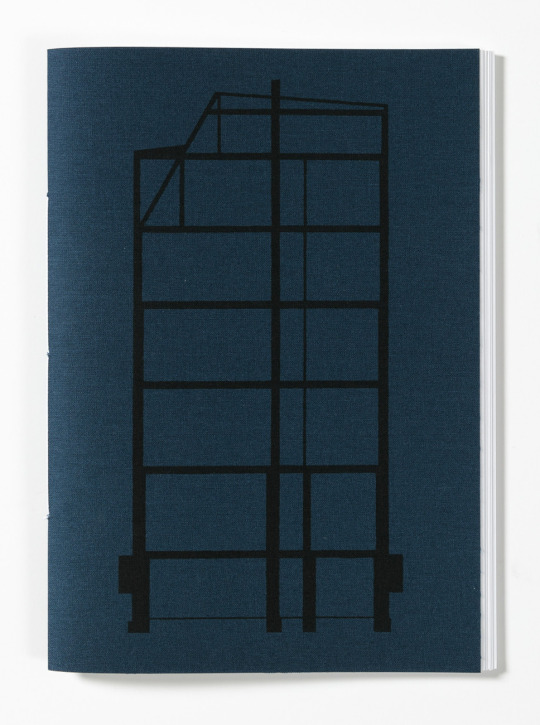


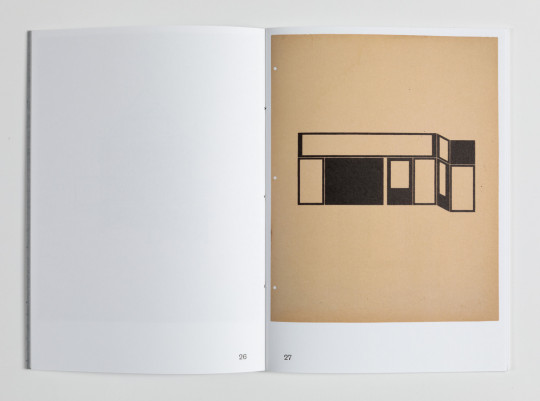


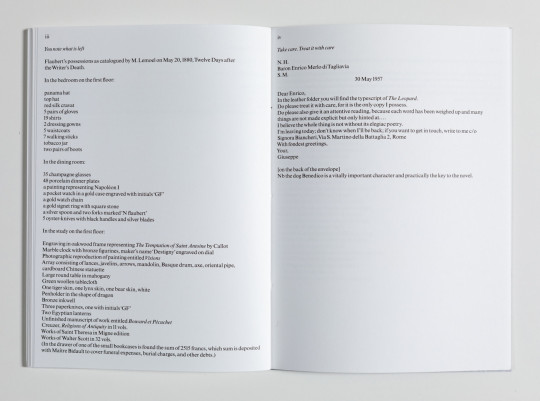
Emily Hass, Exiles, in collaboration with Mike Dyer of Remake Design, contributions by Edmund de Waal, and Kristin Parker, with the support of Frank Williams, 2021 [© Emily Hass]
#graphic design#art#drawing#geometry#book#cover#book cover#booklet#emily hass#mike dyer#remake design#edmund de waal#kristin parker#frank williams#2020s
32 notes
·
View notes
Text
Formula 1 Exhibition in Madrid Explained: Sergio’s Chat with Peter Windsor, Part 3
#F1 Exhibition, Part 3. We are Lotus. @rojoalvolante @dmerinof1
Interview by Sergio Álvarez; photos by Diego Merino & Cyril Nikitenko.
Q: We see a lot of Lotus stuff here, did you feel comfortable with the Lotus F1 branding experiment a decade ago?
A: I didn’t feel comfortable, no. When I think of Lotus, actually, I think of green and yellow, the lovely Lotus badge and maybe the red, white and gold. I wasn’t really comfortable – certainly not comfortable –…

View On WordPress
#f1#bernie ecclestone#carlos reutemann#caterham f1#colin chapman#diego merino#diego merino f1#diego merino photography#enzo ferrari#F1 Exhibition#F1 Exhibition Madrid#f1 the exhibition#f1 the exhibition madrid#formula 1#Formula 1 Exhibition Madrid#formula one#frank williams#lotus f1#lotus f1 team#peter windsor#peter windsor f1#sergio alvarez#sergio álvarez
5 notes
·
View notes
Text

#the last of us#last of us#Tlou#bella ramsey#ellie williams#joel miller#pedro pascal#bill and frank#murray bartlett#nick offerman#HBO#gay couple#lgbtq#lgbt representation#queer pride#Videogames#The last of us hbo#tlou show#WE WIN#Gay#Lesbian#Representation matters#TLOU Geek Memes
31K notes
·
View notes
Text
smut's fun. have you ever read soul crushing, heart aching, head throbbing comfort that makes your eyes burn out of your head to the point where you just have to crawl into a ball because your inner child feels so safe? haha... yeah smuts fun.
#ellie williams x reader#carl grimes x reader#jason todd x reader#dick grayson x reader#anakin skywalker x reader#daryl dixon x reader#rick grimes x reader#jj maybank x reader#vi arcane x reader#rafe cameron x reader#cole walter x reader#steve harrington x reader#eddie munson x reader#frank castle x reader#conrad fisher x reader#alec lightwood x reader#spencer reid x reader#aaron hotchner x reader#jinx arcane x reader#smut#comfort
4K notes
·
View notes